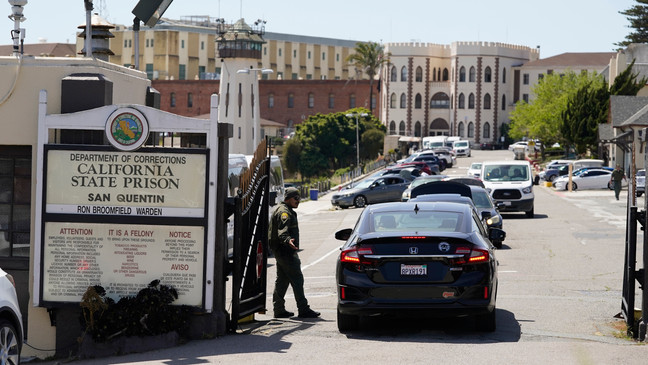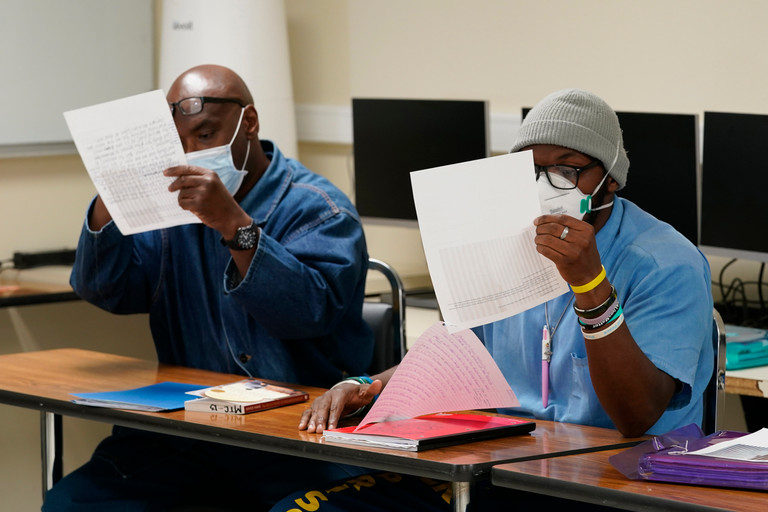
SAN QUENTIN, Calif. (AP) — The infamous state prison on San Francisco Bay that has been home to the largest death row population in the United States will be transformed into a lockup where less-dangerous prisoners will receive education, training and rehabilitation, under a new plan from California Gov. Gavin Newsom.
CA is transforming San Quentin into the most innovative rehabilitation and education facility in the nation. California will incorporate programs and best practices from countries like Norway, which has one of the lowest recidivism rates in the world. We’re creating a safer CA.
-Gov. Gavin Newsom
Listen to the report by KMJ’s Liz Kern.
The Democratic governor discussing his proposed transformation of San Quentin State Prison during a visit on Friday.
The facility will be renamed the San Quentin Rehabilitation Center and the inmates serving prison sentences there will be moved elsewhere in the California penitentiary system. The state has 668 prisoners facing death sentences, mostly men, and about 100 have already been moved, state prison officials said.
“Today, we take the next step in our pursuit of true rehabilitation, justice, and safer communities through this evidenced-backed investment, creating a new model for safety and justice — the California Model — that will lead the nation,” Newsom said in a statement Thursday.
The move by Newsom, who recently began his second term, follows his 2019 moratorium on executions and dismantling of the prison’s gas chamber, as well as his 2022 announcement that some inmates would be moved from San Quentin to other prisons.
It’s part of a decades-long transformation of the state’s sprawling prison system, which went under federal receivership in 2005 after a court determined prison medical care was so lacking it amounted to cruel and unusual punishment. A panel of judges later ordered the state to dramatically reduce the prison population due to overcrowding.
Full details of the plan were not immediately made public, though officials said the facility would concentrate on “education, rehabilitation and breaking cycles of crime.”
San Quentin, California’s oldest prison, has housed high-profile criminals such as cult leader Charles Manson, convicted murderers and serial killers, and was the site of violent uprisings in the 1960s and 1970s. But it’s also been the site of some of the nation’s most innovative inmate programs.
Newsom’s office cited as a model Norway’s approach to incarceration, which focuses on preparing people to return to society, as inspiration for the program. Oregon and North Dakota have also taken inspiration from the Scandinavian country’s policies.
In maximum-security Norwegian prisons, cells often look more like dorm rooms with additional furniture such as chairs, desks, even TVs, and prisoners have kitchen access and activities like basketball. The nation has a low recidivism rate.
At the overhauled San Quentin, vocational training programs would set people up to land good-paying jobs as plumbers, electricians or truck drivers after they’re released, Newsom told the Los Angeles Times.
The Prison Law Office, a public interest law firm that filed the 2001 lawsuit over prison medical care, has advocated for such an approach to prisons and led tours of European correctional facilities for U.S. lawmakers. On a 2011 trip to prisons in Germany and the Netherlands, Donald Specter, executive director of the law office, said he was shocked to see that they were “so much more humane” than prisons back home.
“While I was there, I thought, ‘oh my god, we should try to import this philosophy into the United States,’” he said.
Specter said the rehabilitation-centered approach reduces recidivism, meaning there will be fewer victims of crime in the long run.
A group made up public safety experts, crime victims and formerly incarcerated people will advise the state on the transformation. Newsom is allocating $20 million to launch the plan.
Critics of Newsom’s announcement said it follows continued prioritization of people who have committed crimes over victims.
“We’re in a climate where it’s all about the offenders and the criminals and not about the innocent victims that have been victimized, traumatized, harmed — family members that are devastated living without their loved ones because they were murdered and taken away too early,” said Patricia Wenskunas, chief executive officer of the Crime Survivors Resource Center.
Republican Assemblymember Tom Lackey said his Democratic colleagues should focus more on supporting crime victims.
“Communities win when we have rehabilitative efforts, but yet, how about victims?” Lackey said. “Have we rehabilitated them?”

Meanwhile, some activists say Newsom’s plan doesn’t go far enough. Taina Vargas, executive director of Initiate Justice Action, an advocacy group based in Los Angeles, said she is pleased the state is moving toward rehabilitating incarcerated people but more drastic changes are needed to transform a system that imprisons so many people.
“Over the long term, I think we want to prevent people from going to prison in the first place, which means that we want to offer more opportunities for high paying jobs in the community,” she said.
Amber-Rose Howard, executive director of Californians United for a Responsible Budget, a group focused on reducing the prison population, isn’t convinced a “Norway model” would work in the United States since the two countries have vastly different histories.
“Newsom should stay on track with closing more prisons, with implementing policies that have been passed that would reduce incarceration and that would get people home,” she said.
California voters upheld the death penalty at the ballot in 2016, but they’ve also supported easing certain criminal penalties in an attempt to reduce mass incarceration as part of a more recent movement away from tough-on-crime policies that once dominated the state.
San Quentin north of San Francisco has also been home to some of the most innovative inmate programs in the country, reflecting the politically liberal beliefs of the Bay Area.
The prison houses the first accredited junior college in the country based entirely behind bars, offering classes in literature, astronomy, U.S. government and an Associate of Arts degree.
The prison also runs a newspaper called the San Quentin News, and several prisoners recorded and produced the hugely popular podcast “ Ear Hustle ” while serving time.
Newsom’s announcement comes during a four-day policy tour across California in lieu of a traditional State of the State address.
___
By Sophie Austin, a corps member for the Associated Press/Report for America Statehouse News Initiative.






